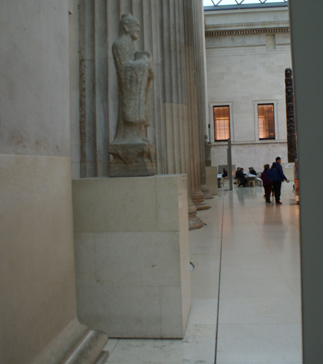The Tutankhamun exhibition was the thing to see in London in 1972 – and hence the thing above all that officials had to protect, to prevent embarrassment of losing the treasures or even letting them come to any harm by accident. While a steady stream of people passed through the British Museum to see the treasures, the greatest risk of harm came while the objects were on their journey to and from their usual home in Egypt.
What of the procedure, to bring in the Tut exhibits? In January 1972, a Met motorcyclist went to the museum to collect a package of photographs of museum staff due to attend Brize Norton, to take delivery. In other words, before the age of fax machines and email, that was the only physical way to match legitimate courier to proof of identity. The Met motorcyclist took the package to Slough police station, where the Thames Valley force took it on to Brize Norton. Another sign of security was a letter from the Thames Valley chief constable to the Met, confirming security for a ‘consignment of valuable exhibits from Brize Norton to the British Museum’; even senior police did not put on paper that it was Tutankhamun. Likewise in a telex message, it was only termed a ‘high value load’.
In January 1972, the shippers sent details of the movement of the artefacts. On arrival at what was then called London Airport, BOAC would position the aircraft at the rear of the cargo centre, for unloading directly on to the shipping company’s vehicle. When loaded, and the vehicle locked, the driver and supervisers would be locked in their cab. On arrival at the museum (at night, the cargo arriving at Heathrow after dark), the museum would shut its gates at once. Then forklift truck would take the items to the museum entrance. A similar procedure would work for cargo from Brize Norton. Mannings in a Hilman saloon and RS Saunders, the museum security manager in a Mini van (such were the motors of the early 1970s) would be part of a convoy to leave Brize Norton at about 11.30pm on Tuesday, January 25, 1972; and reach the Met Police boundary at Denham on the A40 at about an hour later, to rendez-vous with a Met escort. On arrival at Heathrow, airport security officers would be in charge of security there; at Brize Norton, a shipping company representative and two packers would supervise RAF staff transferring the objects to a Tate Gallery four-ton armoured van. Customs clearance would be on the ‘plane; that is, to avoid delay on the ground.
Each of the loads, then, would be in a three or four-ton vehicle; and planners estimated that the time to unload at the museum would be one hour. Chief Supt peter Marshall of the Met after a meeting on the security arrangements in December 1971 reported that Dr IES Edwards, keeper of Egyptian antiquities at the British Museum, asked if the police escort would be armed, ‘and expressed surprise when I told him it would not be. He reluctantly accepted this decision.’
As Jack Mannings out it in a letter date December 8, 1971, to Marshall, ‘…. Every effort is being made to avoid publicity … it might be necessary to divert a flight to another airport in which case as much notice as possible will be given’. The risk of a leak was because so many had to know, such as in the Royal Air Force, the airline BOAC, and Customs. Mannings in a letter of September 1971 to Sir John Waldron, Metropolitan Police Commissioner, recalled that in a November 1969 meeting in Waldron’s office – a sign of how high-level the exhibition was – Waldron had appointed Marshall as liaison officer, ‘because of the strong political atmosphere at the time and for some months afterwards information about the proposed exhibition was strictly controlled … British and Egyptian governments had only just signed agreements’. The exhibition was due to open on March 29, 1972 and run until October. An estimated one and a half million were to attend (and it was so important at the time, the Royal Mail made commemorative stamps of it).
Mannings wrote that ‘extra warding staff will be engaged’ (a sign of those times; what we now regard as customer service staff were likened to, and looked like, prison warders), ‘to guard the exhibits which will be housed in a specially strengthened gallery fitted with electrical devices and alarm systems’. It is felt that the exhibits will be under maximum security while in the museum.’ Mannings asked for police cover during the arrival and transit (which for any goods, such as cash in transit to banks and high streets, is their most vulnerable time). The price of admission to see Tutankhamun; 50 pence, and half price for schools and children.
Waldron signed a memo dated November 17, 1969 on Mannings’ visit. The exhibition was on the occasion of the 50th anniversary of Tutankhamun’s discovery, by the British Egyptologist Howard Carter. President Nasser, the then dictator of Egypt, supported the exhibition and to deal with the project at British government level was Lord Trevelyan. The file ended with a letter signed by Sir John Wolfenden in January 1973, thanking police after it was all over, for ‘the unfailing helpfulness and cheerfulness’ of officers, addressed to Supt Jackaman of Albany Street police station. Wolfenden thanked four officers by name, rather spoiling it by getting the surname of one officer wrong.
Photo by Mark Rowe; inside the covered Great Court of the present British Museum.
Part one of three: the route the exhibits would take in the small hours.
Part two: an unhappy visitor from Hemel.
Tutankhamun: Treasures of the Golden Pharaoh, is running at the Saatchi Gallery in London from November 2019 to May 2020. Visit https://tutankhamun-london.com/tickets/.









